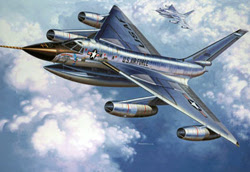B-58 Hustler
Convair
B-58 Hustler
It was the world's first operational supersonic bomber, capable of sustained Mach 2 speeds for up to an hour. Yet, within a decade it was retired from service. SAC, the Strategic Air Command, was never happy with its modest range and its maintenance costs seemed exorbitant against the financial drain that was Vietnam. Finally, its inflexible strategic role was viewed superfluous with ICBMs being the more credible deterrent to nuclear war.
B-58
Crew: 3 - pilot
bombardier/navigator
defense systems operator
Power: 4 - General Electric 7082 kg / 15,600 lb afterburning thrust J79-5B turbojets
Max. Speed: 2128 kph / 1322 mph
Ceiling: 19,520 m / 64,000 ft
Range: 8248 km / 5125 miles
Climb: 5310 m / 17,400 ft per minute
Weight -
Empty: 25,224 kg / 55,560 lb
Max. Take Off: 74,002 kg / 163,000 lb
Size -
Wingspan: 17.32 m / 56 ft 10 in
Wing Area: 143.35 sq m / 1543 sq ft
Length: 29.49 m / 96 ft 9 in
Height: 9.58 m / 31 ft 5 in
Armament:
1 - 20 mm / 0.78 in cannon in tail
8830 kg / 19,450 lb payload - nuclear or conventional
V I D E O
Ordnance
There was no room for a conventional bomb bay in the narrow Coke bottle shaped fuselage so ordnance was kept within a large, streamlined centerline weapons pod tucked beneath the aircraft. The pod's size required the B-58 to have long, mosquito legged landing gear. A wartime mission would normally include five atomic weapons, one for each assigned target. Actual missions would require at least one in flight refueling with a KC-135 tanker.
Delta Wing
Engine pods were mounted outboard of the thin delta wing which had a 60 degree sweep. The speed of the aircraft was not limited by power but by allowable inlet air temperatures and the structural integrity of the aircraft. Sharp cones or spikes protruding from the jets prevented sonic shock waves from entering the engine intakes and disrupting air flow and power.
Pilot Station
Each of the three crew members was isolated in their own separate compartment, arranged in tandem. There was no possibility of stretching your legs during flight. Each flight was carefully planned in advance and personnel were usually too busy to find their situation claustrophobic.
Escape Capsule
Ejecting from an aircraft flying at supersonic speeds is not safe with a normal ejection seat. Each crew member of the B-58 was contained within a specially designed escape capsule that was pressurized and provisioned with oxygen, food, water and flotation equipment. Besides deploying a parachute it had a suspension system to soften the landing.
Crew of the Rapid Rabbit
The Soviet's proven ability to down high altitude aircraft was a game changer for the strategic bomber. The stratosphere was no longer a safe haven for high speed aircraft. B-58 crews now trained to fly close to the deck in order to avoid radar detection but the dense atmosphere at these altitudes slowed speed and gobbled fuel. The role of the B-58 was being crowded out with the deployment of solid fueled Minuteman missiles and the launching of Polaris armed submarines. By 1970 all 87 Hustlers were mothballed to the Arizona desert.
Strategic Bomber
The B-52 survives today because it proved to be a highly adaptable weapons platform, capable of adjusting to changing circumstances and needs. The B-58, on the other hand, was a revolutionary design focused on successfully completing a specific mission. Prior to the deployment of reliable missiles on land and sea there was a strategic justification for the bomber's expense. But while sophisticated defenses can knock most any aircraft from the sky they remain to this day unable to counter an incoming missile attack. The bomber today earns its keep as a tactical weapon in conventional engagements. For these missions there are cheaper, more efficient alternatives to calling on the services of aircraft like the B-58.
OVER EASY











No comments:
Post a Comment